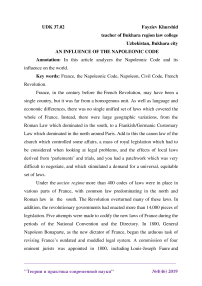An influence of the Napoleonic code
Автор: Fayziev Kh.
Журнал: Теория и практика современной науки @modern-j
Рубрика: Основной раздел
Статья в выпуске: 4 (46), 2019 года.
Бесплатный доступ
In this article analyzes the Napoleonic Code and its influence on the world.
France, the napoleonic code, napoleon, civil code, french revolution
Короткий адрес: https://sciup.org/140274483
IDR: 140274483
Текст научной статьи An influence of the Napoleonic code
France, in the century before the French Revolution, may have been a single country, but it was far from a homogenous unit. As well as language and economic differences, there was no single unified set of laws which covered the whole of France. Instead, there were large geographic variations, from the Roman Law which dominated in the south, to a Frankish/Germanic Customary Law which dominated in the north around Paris. Add to this the canon law of the church which controlled some affairs, a mass of royal legislation which had to be considered when looking at legal problems, and the effects of local laws derived from ‘parlements’ and trials, and you had a patchwork which was very difficult to negotiate, and which stimulated a demand for a universal, equitable set of laws.
Under the ancien regime more than 400 codes of laws were in place in various parts of France, with common law predominating in the north and Roman law in the south. The Revolution overturned many of these laws. In addition, the revolutionary governments had enacted more than 14,000 pieces of legislation. Five attempts were made to codify the new laws of France during the periods of the National Convention and the Directory. In 1800, General Napoleon Bonaparte, as the new dictator of France, began the arduous task of revising France’s outdated and muddled legal system. A commission of four eminent jurists was appointed in 1800, including Louis-Joseph Faure and chaired by Cambacérès, and sometimes by the First Consul, Napoleon himself. The Code was complete by 1801, after intensive scrutiny by the Council of State, but was not published until 21 March 1804. It was promulgated as the "Civil Code of the French" , but was renamed "the Napoleonic Code" from 1807 to 1815, and once again after the Second French Empire. The Napoleonic Code was not the first legal code to be established in a European country with a civil legal system; it was preceded by the Codex Maximilianeus bavaricus civilis (Bavaria, 1756), the Allgemeines Landrecht(Prussia, 1794), and the West Galician Code (Galicia, then part of Austria, 1797). It was, however, the first modern legal code to be adopted with a pan-European scope, and it strongly influenced the law of many of the countries formed during and after the Napoleonic Wars. It codified several branches of law, including commercial and criminal law, and divided civil law into categories of property and family. The Napoleonic Code made the authority of men over their families stronger, deprived women of any individual rights, and reduced the rights of illegitimate children. All male citizens were also granted equal rights under the law and the right to religious dissent, but colonial slavery was reintroduced.
The code was originally introduced into areas under French control in 1804: Belgium, Luxembourg, parts of western Germany, northwestern Italy, Geneva, and Monaco. It was later introduced into territories conquered by Napoleon: Italy, the Netherlands, the Hanseatic lands, and much of the remainder of western Germany and Switzerland. The code is still in use in Belgium, Luxembourg, and Monaco. During the 19th century, the Napoleonic Code was voluntarily adopted in a number of European and Latin American countries, either in the form of simple translation or with considerable modifications. The Italian Civil Code of 1865, enacted after the unification of Italy, had a close but indirect relationship with the Napoleonic Code. The new Italian code of 1942 departed to a large extent from that tradition. In the early
19th century, the code was introduced into Haiti and the Dominican Republic, and it is still in force there. Bolivia and Chile followed closely the arrangement of the code and borrowed much of its substance. The Chilean code was in turn copied by Ecuador and Colombia, closely followed by Uruguaya nd Argentina. In Louisiana, the only civil-law state in the United States (which is otherwise bound by common law) , the civil code of 1825 (revised in 1870 and still in force) is closely connected with the Napoleonic Code. The influence of the Napoleonic Code was diminished at the turn of the century by the introduction of the German Civil Code (1900) and the Swiss Civil Code (1912); the former was adopted by Japan and the latter by Turkey. In the 20th century, codes in Brazil, Mexico, Greece, and Peru were products of a comparative method, with ideas borrowed from the German, French, and Swiss traditions.
However, as the nineteenth century turned into the twentieth, new civil codes in Europe and around the world rose to reduce the importance of France’s, although it still has an influence.
Список литературы An influence of the Napoleonic code
- www.thoughtco.com//A History of the Napoleonic Code (Code Napoléon)
- www.study.com//The Civil Code.
- www.en.wikipedia.org//Napoleonic Code.
- Robert B. Holtman, The Napoleonic Revolution (Baton Rouge: Louisiana State University Press, 1981)
- www.britannica.com// Napoleonic Code


